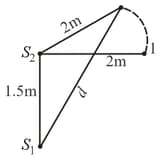Given below are two statements: one is labelled as Assertion A and the other is labelled as Reason R
Assertion A: The phase difference of two light waves change if they travel through different media having same thickness, but different indices of refraction.
Reason R: The wavelengths of waves are different in different media.
In the light of the above statements, choose the most appropriate answer from the options given below
Important Questions on Wave Optics
Which of the following are true?
A. Speed of light in vacuum is dependent on the direction of propagation.
B. Speed of light in a medium is independent of the wavelength of light.
C. The speed of light is independent of the motion of the source.
D. The speed of light in a medium is independent of intensity.
Choose the correct answer from the question given below :
State Huygens's principle of wave theory? Using this principle derive the law of reflection or refraction. Which quantity remains unchangedwhen a light wave suffers reflection of refraction?
In a Young's double slit experiment with light of wavelength the separation of slits is and distance of screen is such that . If the Fringe width is , the distance from point of maximum intensity to the point where intensity falls to half of the maximum intensity on either side is:
Two coherent point sources and are separated by a small distance as shown in the figure. The fringes obtained on the screen will be

Two coherent sources of sound, and produce sound waves of the same wavelength are in phase. and are placed apart (see fig). A listener, located at , directly in front of , finds that the intensity is at a minimum when he is away from . The listener moves away from , keeping the distance from fixed. The adjacent maximum of intensity is observed when the listener is at a distance from . Then is :

On a hot summer night, the refractive index of air is the smallest near the ground and increases with a height from the ground. When a light beam is directed horizontally, the Huygens' principle leads us to conclude that as it travels, the light beam,

